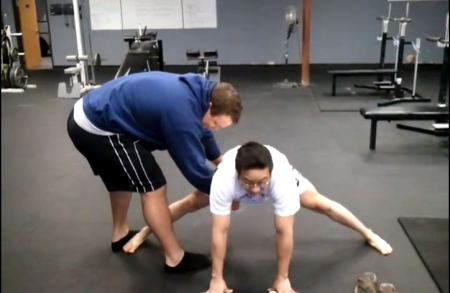Back in November of 2010 Brent Kim was in my living room, lying on the ground with a dumbbell held above his head (jealous yet?). When I asked him “what are you doing?” he responded with “what the f*** does it look like I’m doing? I’m sending my humerus to the posterior portion of the socket”. I said something to the effect, of “OK, c ya!”
Over the next six months, Brent would spend countless hours poring over Kelly Starrett’s MobilityWod.com, and using “informed free styling” to improve his mobility. Brent was pleased to report that his mobility (which he had previously described as horrendous), had improved dramatically. Brent would still refer to himself in a self-deprecating manner, but he told me his training was at least going better.
In mid-2011 I decided that maybe, for once, Brent was onto something. I would spend the next two years (and still do, to this day) trying to learn how to effectively mobilize for better performance in the gym. As we all know, how much you improve in training is directly related to what you do outside of the gym (nutrition/sleep/moping/etc.)
A few months back I finally received my pre-ordered copy of Dr. Kelly Starrett’s “Becoming a Supple Leopard”. I am pleased to report that after reading through it, and referring to it multiple times a week, it’s as indispensable as a belt (Brent), a lacrosse ball, and a PVC pipe (i.e. you should have them). If you’ve watched any of the videos on MobilityWod.com, you’re familiar with Starrett’s style. He uses terms like “bleeding force” and “dumping torque” routinely as a method for describing how your performance is limited in some capacity by a mobility restriction/incorrect movement pattern. This book is written much in the same manner as his videos, but in my opinion, far easier to understand.

In addition to describing his definition for mobilization, Starrett explores subjects such as midline stabilization, the one joint rule, laws of torque, and movement hierarchy. This information precedes describing how to correctly perform numerous exercises. Finally, if you’re having issues with a particular movement, he details how to isolate the issue, and how to fix it.
Starrett describes that pain is often a lagging indicator. It isn’t just that your knee hurts, there is an explanation for the pain in your knee that often begins with tightness upstream/ downstream of the pain, or an incorrect movement pattern. Starrett’s systematic approach to figuring out what’s wrong with you is also extremely flexible. You work on your hip mobility, and your knee pain still exists. Then, you move to your ankles, and discover that they’re incredibly tight because you wear combat boots all day (this is from personal experience).
Without spending anymore time telling you why you should read it, you need to either buy a copy, or borrow it from someone. There will be people out there that tell you what Starrett preaches has no real value. As far as I’m concerned, they’re the same people that tell you that you should stop squatting because there is a leg press in the corner and it’s “easier on the knees”. Still not a believer? Spend five minutes of your time with a lacrosse ball, curse me, then go to Amazon and make one of the best $35 investments you can make for your training.
 Mike Battaglino is a 70’s Big member that regularly contributes to his blog at 70sbig.com/mike, and makes videos about chicken shakes/analyzing technique/other random training advice. When he isn’t training or making videos, he’s declining your offer for a spot. Spot?
Mike Battaglino is a 70’s Big member that regularly contributes to his blog at 70sbig.com/mike, and makes videos about chicken shakes/analyzing technique/other random training advice. When he isn’t training or making videos, he’s declining your offer for a spot. Spot?

